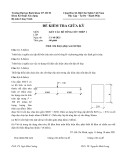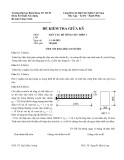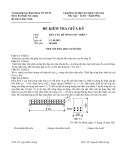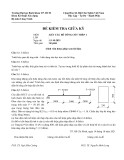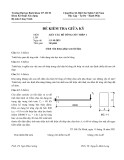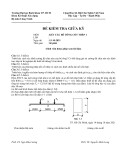
Journal of Science and Transport Technology Vol. 2 No. 2, 1-12
Journal of Science and Transport Technology
Journal homepage: https://jstt.vn/index.php/en
JSTT 2022, 2 (2), 1-12
Published online 10/05/2022
Article info
Type of article:
Original research paper
DOI:
https://doi.org/10.58845/jstt.utt.2
022.en.2.2.1-12
*Corresponding author:
E-mail address:
anhnt@utt.edu.vn
Received: 07/12/2021
Revised: 29/04/2022
Accepted: 02/05/2022
Prediction of shear strength of corrosion
reinforced concrete beams using Artificial
Neural Network
Panagiotis G. Asteris1, Thuy-Anh Nguyen2*
1Computational Mechanics Laboratory, School of Pedagogical and
Technological Education, Heraklion, GR 14121, Athens, Greece
2University of Transport Technology, Hanoi 100000, Vietnam
Abstract: The shear strength of corroded reinforced concrete (CRC) beams is
a critical consideration during the design stages of RC structures. In this study,
we propose a machine learning technique for estimating the shear strength of
CRC beams across a range of service periods. To do this, we gathered 158
CRC beam shear tests and used Artificial Neural Network (ANN) to create a
forecast model for the considered output. Twelve input variables indicate the
geometrical and material properties, reinforcing parameters, and the degree of
corrosion in the beam, whereas the shear strength is the output considered.
The database is designed to employ 70 percent of the data point to train the
model and 30 percent to assess the performance. The model makes
outstanding predictions, according to the results, with an R2 value of 0.989. In
addition, five empirical shear strength models in the literature are utilized to
test the suggested ANN model, demonstrating that the new model performs
much better. With any given service period, the suggested time-dependent
prediction model can offer the shear strength of CRC beams.
Keywords: Artificial Neural Network, Corrosion Reinforced concrete beams,
Shear strength.
1. Introduction
In reinforced concrete (RC) constructions,
corrosion of reinforcing bars is one of the most
prevalent causes of early deterioration, which
results in reduced service life. The corrosion of
reinforcing bars has been demonstrated to impair
the load capacity of RC members in previous
studies [1]–[4]. Corrosion also reduces the area of
reinforcement, has an effect on the mechanical
characteristics of reinforcing bars [5], and causes a
loss of bonding qualities between the steel
reinforcement and the concrete matrix [4], [6]. This
means that failure modes may shift from flexural to
shear even if the beams are well-designed in the
first place. As a result, it is vital to precisely forecast
the shear strength of corroded RC (CRC) beams,
especially during their entire life cycle, in order to
ensure the structural integrity and safety of the
structures [7].
A number of analytical or empirical formulas
for determining CRC beams' shear strength have
been developed to date, including those based on
the strut-and-tie model (STM) [8], [9], modified
compression field theory [9], equivalent truss
theory [10], limit equilibrium theory [11], and design
codes (i.e., ACI 318-02, ACI 318-08, ACI 318-14)
[8], [9], [12]. In Lu et al. recently [13], a detailed
assessment of a large number of empirical shear
strength models for CRC beams was completed.
This resulted in developing a unique model for









